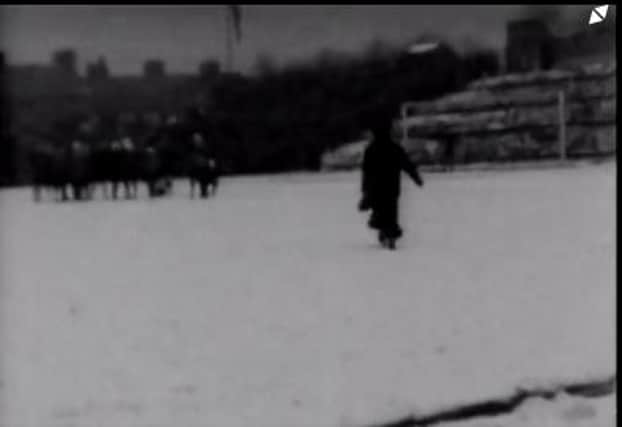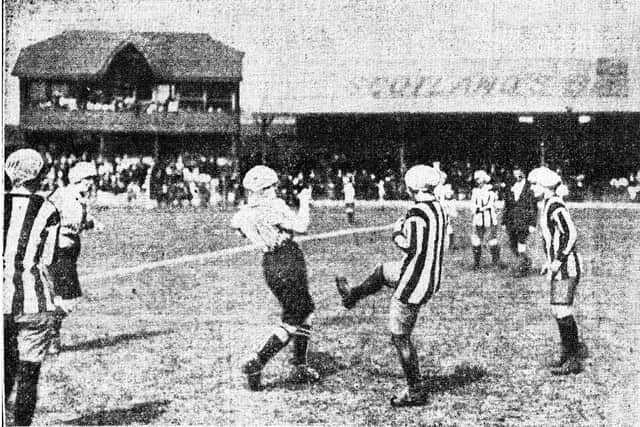Magical footage shows South Tyneside and Hartlepool female footballers playing in snowy Munitionettes' Cup final at Newcastle's St James' Park in 1919


The black and white footage features the team from Palmers Shipyard (Jarrow & Hebburn) playing that of Christopher Brown Ltd of Hartlepool.
It can be viewed online here:


Advertisement
Hide AdAdvertisement
Hide AdThe accompanying caption states: "Women’s football cup game played in the snow. Munition girls team. This could be final of The Munitionettes' Cup - the winners being the ladies of Palmer's shipyard in Jarrow, who defeated Christopher Brown's of Hartlepool 1-0 at St James' Park in Newcastle on 22 March, 1919."
South Tyneside playwright Ed Waugh, whose new play Wor Bella will tour the region in March, has been researching women's football during WWI for the play and can confirm that this is definitely footage of the 1919 cup final.
He explained: "When men were massacred at the likes of the Somme in 1916 and Ypres the government introduced conscription into the army for men, consequently hundreds of thousands of women flooded into the munitions factories to save the WWI war effort
"Around a million women became munitionettes, working long, hard, dangerous and physical 60-hour weeks in shipyards, armaments factories, docks, rope mills, steel mills, etc.


Advertisement
Hide AdAdvertisement
Hide Ad"Little provision was made by the government for the injured soldiers so we saw the phenomenon of these munitionettes playing football to raise money for wartime charities that looked after maimed and blinded men, widows and orphans.
"There were no leagues. Matches were regarded as "friendlies". Hundreds of teams formed throughout the country and there were dozens in the North East. What distinguished our region was a cup donated by Sunderland businessman Alfred Wood."
The best teams from Hartlepool, Middlesbrough, Darlington and North Yorkshire battled it out to find their champion and teams from Wearside, Tyneside and Northumberland held a knock-out to find their top dog. Matches attracted thousands of attendees
The two best teams in the region would then play in the final. The 1918 Munitionettes cup was won by Blyth Spartans who defeated Bolckow Vaughan from Middlesbrough 5-0 at Ayresome Park, Middlesbrough, in front of 22,00 people.
Advertisement
Hide AdAdvertisement
Hide AdBella Reay, the Blyth Centre forward, notched a hat trick in the final and ended the season with 133 goals in 30 matches. Affectionately known as Wor Bella, she is regarded as the "Alan Shearer of her day".
Guesting for Blyth Spartans Ladies that day in March 1918 was Palmers (Jarrow) star, 16-year-old Mary Lyons who, a year later, led her own team to victory in the cup.
There were only ever two munitionettes cup finals and only Bella Reay and Mary Lyons were double victors.
Guesting for Palmers in 1919, Bella Reay scored the only goal of the game in Jarrow's 1-0 victory over Christopher Brown Ladies.
Advertisement
Hide AdAdvertisement
Hide AdEd said: "Our research shows there was footage of the 1918 final but we couldn't find that. When we came across the 1919 film hidden away on the internet it was an incredible feeling.
"The entrance onto the field is from the former popular end and in the background is the old Leazes End. I can remember both from the 1960s and 70s."
Ed's wife Jane recognised the rooftops of the houses on the on the far side of the pitch, which are still there, where she once worked.
Ed continued: "The pitch is covered in snow. I contacted Paul Mooney from BBC weather and he put me in touch with the national Metrological Office who confirmed it was snowing on Tyneside on the weekend of March 22. 1919. One player even gets carried off the pitch through injury, no doubt sustained because of the icy conditions."
Nine thousand spectators attended the event.
Advertisement
Hide AdAdvertisement
Hide Ad"Sadly, Bella Reay's only goal of the match is not recorded in the footage," said Ed.
"But what is intriguing is the good quality of football despite the atrocious conditions, and how 17 year old Mary, captain of Palmers, allows Bella to lift the cup. Mary is second in line.”
Ed continued: "I can only assume this is because Bella scored the winning goal. There must have been a strong friendship between them because they played in the two cup final teams together as well as for England and in regional representative matches."
Both Bella Reay, born in 1900, and Mary Lyons were the only two players to win two Munitionettes Cup winners' medals. The North East-based competition ceased to exist after 1919.
Advertisement
Hide AdAdvertisement
Hide Ad"It's an incredible, historic piece of footage from more than 100 years ago that captures the spirit of women's football. The female footballers of today stand on the shoulders of these heroic, selfless, women from WWI,” said Ed.
"The sad upshot is not a single statue exists to the millions of munitionettes who saved the WW1 war effort. Even more incredulous is that there are no war memorials dedicated to these selfless, heroic munitionettes."
Wor Bella premieres in Blyth Phoenix Theatre on Friday, March 25, then tours until to Saturday, April 2, when it plays the Westovian Theatre, South Shields. For further details visitwww.worbella.co.uk
An added twist in the tale of women's football from 100 year ago is that on December 5, 1921 - coming up to 100 years ago - the Football Association (FA) outlawed female teams from playing on FA grounds and using FA officials or any FA-run facilities, effectively banning women's football.
On Boxing Day 1920 when Dick Kerr Ladies played St. Helen's Ladies at Goodison Park (home of Everton FC). More than 53,000 crammed into the stadium, with thousands more locked out. It was, then, a world record for football attendance.
Then in April 1921, coal owners were given back their mines by the government after they had effectively been nationalised for the war effort.
The bosses immediately demanded a wage cut of up to 45% to "restore profitability". It led it a lockout and terrible deprivation in mining areas where families were callously thrown out of company houses and faced harsh deprivation and even starvation.
Football teams were again formed and finances were raised for the families of miners. The pitmen were defeated after three months and the pits re-opened; miners were forced to take a huge pay cut.
The thought of women's football becoming more popular than men's football and the political aspects of the football teams during the 1921 miners' strike led to the FA's overtly political and vindictive ruling on December 5, 1921, that women's football was to be banned.
It was undoubtedly about male control and re-affirming the well-established (subservient) role of women in society.
Doctors and other paid apologists were wheeled out to say women's "weak" bodies were unable to withstand the physical rigors of football. This propaganda after they'd been playing for five years and had proved they were perfectly capable of carrying out difficult "men's" work!
Advertisement
Hide AdAdvertisement
Hide AdThe ban wasn't revoked until in 1971, and it wasn’t until 2008 that the FA issued an apology.
A 1902 FA ruling that mixed-sex football for over 11 year olds stayed in force until 2014 when it was decreed that men and women over the age of 18 still couldn't play football together.
"There is obviously still a long way to go," said Ed.
Women's football is today the fastest growing sport in the world but the players of today stand on the shoulders of those selfless munitionettes who defied the acidic tongues of their detractors to play football in WW1.
Both Northumberland and Durham FAs supporting Wor Bella.